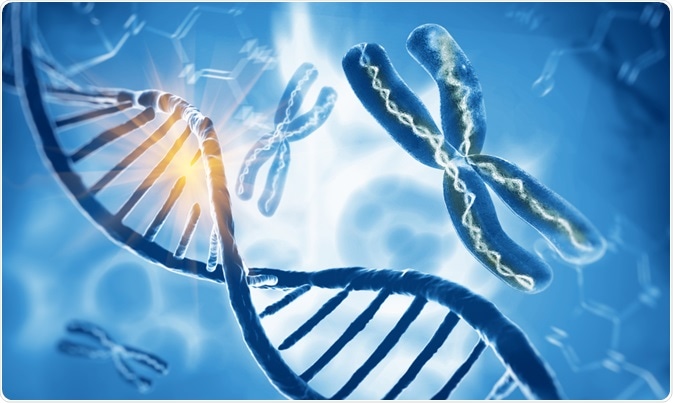Muscular dystrophies represent a group of more than 30 molecular and clinically heterogeneous genetic disorders, which cause progressive degeneration of the skeletal muscle fibers. Their main feature is severe muscle weakness that predominantly affects the limb, axial, and facial muscles to a variable degree.
The severity of the disease, age of onset, and rate of progression vary significantly in the different forms of muscular dystrophies. The primary cause of various disease forms can be pinpointed to a particular mutation in genes encoding a myriad of proteins including extracellular matrix proteins, membrane-associated proteins, nuclear proteins, and cytoplasmic proteases.

Image Credit: Giovanni Cacemi / Shutterstock.com
Pattern of inheritance
The genetic cause of muscular dystrophy is passed from one or both parents to an offspring by a specific pattern that varies depending on the type of muscular dystrophy. The three primary types of inheritance are known as X-linked recessive, autosomal dominant, and autosomal recessive. It must be noted that mutations can always develop “de novo,” which indicates that a lack of a family history of the condition does not rule out the possibility of muscular dystrophies.
In the process of reproduction, male and female gametes, which are known as sperm and eggs, respectively, contribute one sex chromosome each. A set of sex chromosomes in males is XY, while females have XX sex chromosomes; hence, the male can contribute the X or Y chromosome, whereas females contribute one of their X chromosomes. A male infant is a result of males contributing their Y chromosome, whereas a female infant is the result of X chromosome contribution from both parents.
Duchenne and Becker muscular dystrophy, as well as some types of Emery-Dreifuss muscular dystrophies, arise as a result of mutations on one of the X chromosomes carried by the female parent. The aforementioned muscular dystrophies affect 50% of male infants, whereas the daughter of a carrier has a 50% chance of becoming a carrier and can occasionally experience mild symptoms. This type of inheritance pattern is known as X-linked recessive inheritance.
Myotonic dystrophies, facioscapulohumeral muscular dystrophy, oculopharyngeal muscular dystrophy, some types of congenital muscular dystrophies, and some types of limb-girdle muscular dystrophy can develop if either of the parent's chromosomes carries the defect, which is subsequently passed to the infant. This type, known as autosomal dominant inheritance, can affect both sexes, with the severity of the disease varying greatly.
A majority of congenital muscular dystrophy types, a rare form of Emery-Dreifuss muscular dystrophy, as well as some types of limb-girdle muscular dystrophies, arise when both parents pass on the faulty gene, therefore causing both copies of the gene in question to be abnormal. Although parents do not exhibit any symptoms, each of their offspring, regardless of their sex, will have a 25% chance of developing the disease. This is called autosomal recessive inheritance.
Main mechanisms leading to muscular dystrophy
The exact mechanisms of muscle weakness in muscular dystrophy eluded scientists for a long time. However, it became clear that the molecular causes responsible for performance hindrances in these diseases involve both functional and structural modifications of the actomyosin interactions.
It has been demonstrated that most muscular dystrophies share some common pathologic features, such as altered homeostasis of calcium ions, an increase in profibrotic cytokines, proteolytic enzyme activation, infiltration of muscle tissue by inflammatory cells of the immune system, metabolic and mitochondrial alterations, defective autophagy, and intracellular accumulation of reactive oxygen species (ROS). Each of these features can contribute to muscle wasting.
At the early stage of the disease, reduced protein content in myofibriles, which are the basic rod-like units of a muscle, can arise in apparently uninjured tissues as a result of an imbalance between protein synthesis and their breakdown. That is followed by consecutive rounds of muscle degeneration and regeneration, leading to fibrosis and fatty replacement of muscle tissue. Taken together, these cellular activities form the basis of the pathological findings in muscular dystrophies.
References
Further Reading